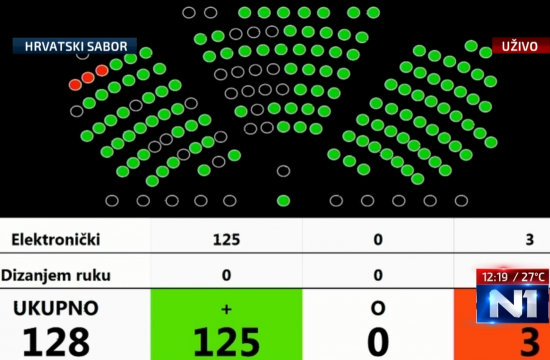
The growth of the Croatian GDP this year will be the second highest in the EU and will remain among the highest in the next two years, while inflation should fall from this year's 8.1% to 2.4% next year and to 1.67% in 2025, the European Commission estimates in its Autumn Economic Forecast.
The Croatian economy is expected to grow by 2.6% this year, which is the second highest growth rate in the European Union after Malta, whose GDP is forecast to grow by 4%. Next year, Croatia’s growth is projected to slow to 2.5% before picking up to 2.8% in 2025.
The EU economy is forecast to grow at a modest rate of 0.6% in 2023, 1.3% in 2024 and 1.7% in 2025. The forecast for the euro area economy is similar – growth is projected at 0.6% in 2023, 1.2% in 2024 and 1.6% in 2025.
“Croatia’s GDP is expected to grow at a sustained pace, supported by increasing private consumption amid rising real wages, and by investment boosted by EU funds,” the Commission said.
Employment growth remains solid. It is expected to grow by 2.1% in 2023 and by 1.1% in 2024 and 2025. Unemployment is expected to reach record-low levels, dropping to 6.5% in 2023, 6.2% in 2024 and 5.8% in 2025.
The expected moderation of headline inflation is driven by lower energy and unprocessed food prices, while services inflation is projected to remain more persistent. The general government balance is set to be negatively impacted by large increases of public sector wages and social benefits putting pressure on expenditure.
Croatia’s economy expanded strongly in 2022, by 6.3%, supported by solid private consumption growth despite high inflation.
Real GDP growth is expected to remain solid at 2.6% in 2023 as Croatia takes advantage of its accession to the euro and Schengen areas.
Consumer demand is set to remain high amid employment and real wage growth. Both government consumption and investment are projected to contribute positively to growth, with investment largely supported by increased absorption of EU funds.
Net exports are projected to positively contribute to GDP growth as a decrease in goods imports more than offsets lower goods exports, and amid overall strong tourism demand.
Growth mainly driven by domestic demand
In 2024, real GDP is expected to grow by 2.5%, mainly driven by domestic demand as headline inflation falls towards 2%. The contribution from net exports is set to decrease substantially but remain positive, supported by increasing demand in the main trading partner economies.
Growth in 2025 is forecast to reach 2.8% and remain broad based, also supported by the increased absorption of Recovery and Resilience Facility grants and loans.
The main risk to the economic outlook is a slower-than-expected decline in inflation, which has been more persistent in Croatia than in most of the euro area.
Should wage increases intensify, after having already resulted in comparatively higher unit labour costs growth, they could lead to possible wage-inflation spirals. This risk may be exacerbated if wage cost pressures are not absorbed by firm profits, which increased in 2022 and early 2023. Under such scenario, the trade balance could deteriorate amid strong domestic demand growth, while exports cost competitiveness could be endangered.
The employment rate should continue growing despite a slight decline in total population. Upskilling and reskilling measures envisaged in the National Recovery and Resilience Plan are intended to help workers transitioning to expanding sectors.
HICP inflation is projected to soften to 8.1% in 2023, and drop to 2.4% in 2024 and 1.6% in 2025 as decreasing energy and unprocessed food prices partly offset persistent, although decelerating, price increases in services and industrial goods. HICP inflation excluding energy and food is expected at a somewhat higher 8.3% in 2023, 3.5% in 2024 and 2.7% in 2025.
This forecast incorporates the effect of the assumed phase-out of measures to mitigate the impact of high energy prices as of end of March 2024.
In 2022, fiscal revenue grew markedly on account of strong real growth and inflation, helping turn the deficit into a small surplus of 0.1% of GDP.
High windfall revenues in 2023, supported by continued strong economic activity and high inflation, are expected to be more than offset by high increases in wages and social benefits. This is set to result in a small general government deficit of 0.1% of GDP in 2023.
In 2024, the deficit is expected to widen to 1.8% of GDP, affected by further upward adjustment of public wages and social benefits beyond inflation and higher nationally-funded investment. Indirect tax revenues are set to remain constant as a share of GDP, while direct taxes and contributions should benefit from positive employment and wage developments despite significant increases in tax exemptions.
The general government deficit is projected to rise from this year’s 0.1% of GDP to 1.8% of GDP in 2024 and 2025. The debt-to-GDP ratio is expected to drop significantly from 68.2% in 2022 to 60.8% in 2023, and public debt is forecast to continue decreasing, reaching 58.8% of GDP in 2024 and 58.2% in 2025. This decrease is mainly due to strong GDP growth, while the deficit increases and stock-flow adjustments are projected to reverse.





Kakvo je tvoje mišljenje o ovome?
Budi prvi koji će ostaviti komentar!